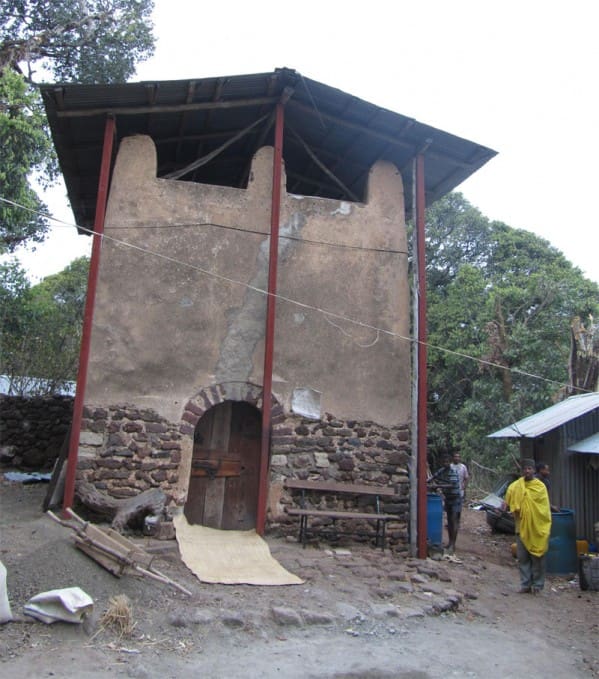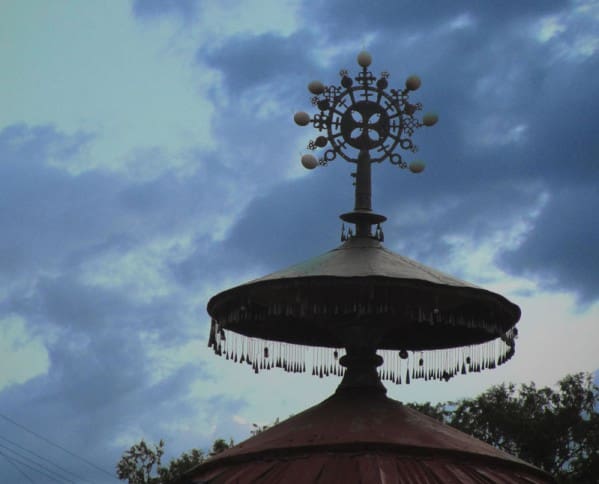Scattered throughout the vast Bahir Dar Lake are seven sacred islands, each home to an ancient monastery, where monks still live in seclusion and contemplation

The foundation to this building is ancient; the superstructure was built after it was burned/destroyed. The top part shows the influence of the Portuguese Jesuits of the 16th century, a particularly bloody period in the religious wars that have swept over Ethiopia with regularity. The cheerful guy in yellow to the right in the picture is the learned monk who cares for the priceless documents and treasures locked in the basement. There are also caves winding underneath this island; natural lava tubes that were used as retreats for the hermits - and are still used for that purpose today.
The lake is the source of the Blue Nile (more pictures on that in a bit), and just getting to the islands required a long boat trip through very rough waters. The bow kept getting swamped, and I was soaked to the bone by the time we made landfall. Apparently, the winds kick up in the afternoon, which is why there are so few (as in none) that will go out on tourism missions at that time. However, I had spent an extremely frustrating morning wrestling with the laissez-faire attitudes at Ethiopian Airlines (where the offices are rarely open to the public, apparently), so I wasn’t entirely in control of when I went.
Anyway, at the periphery of the island is a weathered stone dock. There used to be big tires as bumpers, but the local kids have swiped these and use them as toys.
To get to the sacred places, it’s a half-hour hike, all up steep and winding paths, paved with jagged volcanic rocks, through dense undergrowth that is dotted with ancient coffee bushes.

I met this boy on the path. He said that he makes the trip three times a day lugging this 5-gallon jerrycan to get water from the lake. Where I had to carefully pick my way, even wearing thick-soled shoes, he was as nimble as a mountain goat. I will post a video of our conversation in a bit.
More about those later.
The islands are inhabited by people who scratch out a living from the combination of fishing and selling souvenirs to the rare tourists who show up here. I was impressed by the fact that the first few stalls that we passed by were empty – but by the time we made our way to the top of the hills, the locals had rushed down and arranged rows of their little treasures and were desperate to sell to the lone ferengi (foreigner) who had stumbled across their little island on a Thursday afternoon.
The first monastery I went to was built in a circular shape; it symbolizes the nature of eternity. That everything goes in a circle, unbroken, with no beginning and no end.
There are 12 entrances to the monastery, one for each of the apostles. The paintings are a fascinating insight into the layers of history that have washed over this place, and left their marks.
The original paintings and carvings date back to the 1200s (or perhaps earlier), when the forces of Islam started disobeying the commandments of Mohammed and embarked on a campaign of burning and destroying Christian churches. This would not be the last time this happened. The monks, desperate to preserve their sacred writings – bibles that date back to the 4th century or so – fled to the highlands here, and out into the monasteries on this lake, where they could hide from the conquering hordes.
Among the treasures that they brought up to this region was the fabled Ark of the Covenant. Yeah, the thing that Indiana Jones used to melt the faces of a bunch of Nazis back in 1937. And no, there is not a giant warehouse where it is stored, along with a crystal skull or any other such nonsense (or so says my long-suffering guide).
On top of the monastery is a peculiar decoration – ironwork, festooned with ostrich eggs, which apparently symbolize fertility and rebirth. I’ll get to the amazing artworks that decorate the walls in the next post.
Meanwhile, the legend is that the monk who founded the first monastery (see in the first picture, above) was living in a cave, minding his own business. Like you do when you are a monk. Only the locals kept having sacrifices to a giant python that they worshiped. He came storming out of the cave and (as legend has it) called on god, did some angry preaching, and the giant python croaked on the spot. Which kinda impresses the locals, when you kill their pagan god and all. So they all converted and the monk figured he might as well build something on the spot over the caves where he’d been hanging out (better ventilation, some sunshine now and again, maybe even a chimney).

This bit of decoration features ostrich eggs at the ends of the spikes. Not sure if the eggs are petrified, hollowed out, or these are just replicas. I'm guessing they aren't still real, or they'd be rotten away by now & need frequent replacement, especially in this heat. The ornate spray of metal curlicues around the cross has a distinct meaning to those who know; the circle motif in the center is apparently a mark of Axum.
